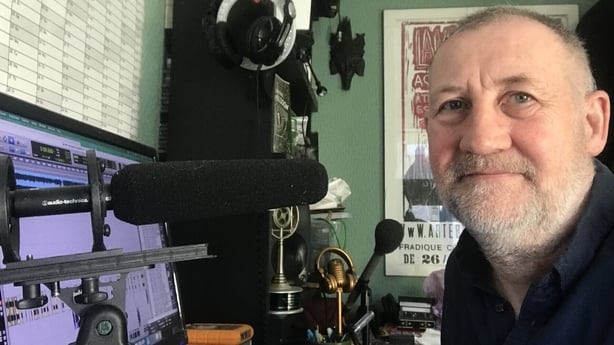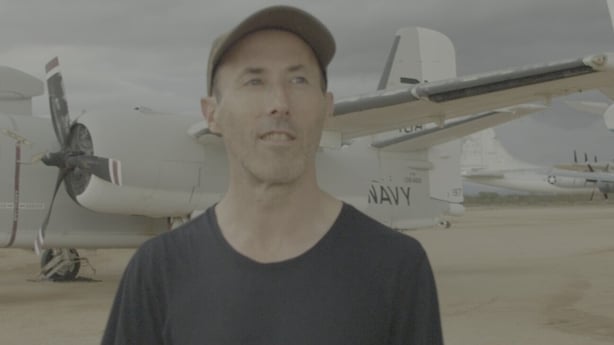An investigation into one of the oldest unsolved cases on the FBI's books, spanning six decades...
Joseph Maloney remains wanted on a charge of first-degree murder having escaped justice in both the United States of America - and Ireland.
After their global hits Finding Samantha, The Nobody Zone and GunPlot, Anna Joyce introduces the latest series from RTÉ's Documentary On One team.
See rte.ie/runawayjoe for more
People have been hungry for true crime stories long before the advent of Netflix or Spotify. In fact, the genre is believed to stretch back as far as the 16th century. In 1888, Londoners went mad for news reports on Jack the Ripper and in the 1960s Truman Capote’s work In Cold Blood revolutionized the genre.
But since the advent of modern technology, the role of the humble true crime fan has expanded. Now, we do not have to sit idly by and merely scream at whatever screen we are consuming from, now we can participate.
The Australian podcast The Teacher’s Pet led to a man being jailed for his wife’s murder nearly 40 years after the fact. RTÉ's The Nobody Zone retraced the footsteps of Ireland’s most prolific serial killer, and reopened a cold case most people (including the authorities) did not know existed.
True crime is not just a form of entertainment; it is a way to dismantle justice systems, reignite cold cases and give victims the closure they deserve.
In 2019, the Dutch police decided to capitalise on the popularity of true crime podcasts and launched a podcast to encourage people to submit tips about a 1991 cold case.
Impassioned justification of why this genre is much more than merely entertainment aside... how does someone resurrect a forgotten case?
How do you get a victim's family to speak to you? How do you get law enforcement officers to hand over case files? Most importantly, how do you find case-breaking information on a crime that has been dormant for years, if not decades?
Honestly, I have no idea. I've done one investigative piece in my career, and it nearly gave me an ulcer.
Thankfully, documentary makers Pavel Barter and Tim Desmond are experts in this area. The pair have teamed up on a new podcast for the award-winning RTÉ Documentary On One team called Runaway Joe.
The podcast reexamines the murder of June Maloney, a 26-year-old mother of two who was poisoned at her son's fifth birthday party nearly 60 years ago.
Her husband, Joseph Maloney, was charged with her murder. But he has managed to escape not only US law enforcement but the Irish authorities as well. It is one of the oldest unsolved cases in the FBI's books.
Across the series, the first two episodes of which drop this Friday, the team will dissect this fascinating case.
Who knows, they might even catch a fugitive…
How did you find this story? And why was it so compelling?
PAVEL: I landed upon this story in the most unusual and serendipitous of circumstances. I was editing the Culture section of the Sunday Times newspaper one week and reading through a journalist’s review of a memoir by Judge Gillian Hussey called Lessons From the Bench: Reflections on a Career Spent in Ireland's Criminal Courts.
The review included an anecdote about an extradition hearing that Judge Hussey oversaw, early in her career on the bench in 1985, involving a man from the Dún Laoghaire area who claimed to be Michael O’Shea but was in fact an American by the name of Joe Maloney: a man on the run for allegedly murdering his wife June Fisk in the 1960s.
When the extradition treaty between Ireland and the United States collapsed, following his hearings in Dublin in 1986, Maloney vanished and had never been seen since. I was instantly intrigued and went down the rabbit hole of this long and circuitous story, speaking firstly to Judge Hussey and then to others: in law enforcement in the United States and Ireland. Then people who knew June and Joe.
From there, the story unfolded for me and the team in RTÉ Documentary on One in ways we could never have imagined.
How do you start an investigation on a case that has been closed for nearly 60 years? How do you go about tracking a fugitive?
TIM: You go back through newspaper archives, court documents, and any publicly available material. That’s where you find names and locations of people who knew him, dealt with him, or were related in some other way to the story. Then it’s a matter of contacting those people and talking through their memories. Not everybody is going to want to talk, but they can still provide vital information that leads the investigation forward.
Because the story goes back over 60 years some people who could help have already passed on, but in some cases, what they leave behind can be very useful. In this case, people who knew the victim, June, were eager to help us. Then you run it like any investigation, chasing down leads, trawling through social media, more court documents and public records until the pieces start making sense in terms of the bigger story.
PAVEL: An advantage we had in approaching this story in 2022/2023 was, quite simply, the passing of time. The story had slipped into the mists of the past, which worked out quite well for Joe Maloney and his wife Sheila Chandler O’Shea.
People – including law enforcement - forgot and moved on. But the passing of time also meant that some of Maloney’s associates, who may not have talked about this case in 1995 or even 2005, were willing to do so now because what else is there left to hide? Anyone who might have been afraid of Joe in the past has nothing to fear now. He’s either dead or – if alive at 88 – poses no threat we assume.

People involved in the original case like Judge Gillian Hussey gave exclusive interviews to the podcast.
Why do you think this story has stayed with people so long?
PAVEL: Joe Maloney was "the one that got away". There is a sense of regret from people we spoke to in law enforcement that Joe was never held accountable for June’s alleged murder.
He may have literally got away with murder. So there is a sense of unfinished business amongst the police, prosecutors and FBI in the U.S., and the Garda and judicial system in Ireland.
For people who knew Maloney (or Michael O’Shea as he was known in Ireland), he was not someone you would forget easily. He was large, garrulous, rambunctious, a natural raconteur, even though he had built his life in Ireland on complete fabrications.
What was the most shocking element of this story that you have uncovered?
TIM: That this is not just a murder story; what we’re discovering is that it’s also about coercive control and domestic violence, and the complete abandonment of young children who lost everything because of what happened.
Serious crimes are very often shocking and can be easily sensationalised. Even though this crime took place 57 years ago, the effects of June’s murder still ripple through today and continue to have a profound effect on some of those affected by her death. It is this, along with perhaps finally getting some sense of justice for June herself, that has been the motivation for us in wanting to track down Joe Maloney.
How did you gain access to so many police statements associated with the case? For example, the statement given by Dale, June’s brother.
PAVEL: The District Attorney’s office in Rochester has been extremely helpful in allowing us to tell this story. We particularly appreciate the efforts of Wendy Lehmann, a retired prosecutor for the DA’s office who oversaw Joe Maloney’s attempted extradition from Ireland in the 1980s.
Wendy provided us with access to on-the-record testimonies, which allowed us to paint a fuller picture of the evidence that led to Maloney being charged with murder and the historical events around his discovery in Ireland in 1973 – where he was living under the pseudonym Michael O’Shea – and attempted extradition from Ireland in the mid-1980s.

What kind of information do you want people to submit to the Runaway Joe tip line?
TIM: There are people out there who know what happened to Joe Maloney, particularly after 1986 (when he went on the run again). Because he came across as so plausible (and stuck by his claims of innocence), maybe at the time, those people thought they were doing the right thing.
But listening to our investigation and what we’ve learned, they might realise that information they have might help solve the mystery and bring closure to the family of the victim, in this case, his ex-wife June, and his children.
Any information, even if you think it’s not particularly relevant, could help us resolve this historic murder case (NB: If you have any information, knowledge or photographs of Michael O’Shea/Joe Maloney, please send them through to documentaries@rte.ie)
The topic of coercive control is raised a lot throughout the podcast – Why was it important to highlight this issue?
PAVEL: Runaway Joe tells the story of a man indicted for allegedly poisoning his wife at the birthday party of their five-year-old son in upstate New York in 1967.
The District Attorney in Rochester has provided us with on-the-record police testimonies from the time as to the nature of their marital relationship. Although this is an unusual story, many of the specificities of this case are commonalities on the spectrum of coercive control and domestic abuse in 2024. For example, in the early years of their relationship, Joe was extremely controlling around their finances. June was trying to leave him; Joe wouldn’t let her go.
Most domestic homicides take place within a year of the victim leaving the abuser: and such was the case with June Fisk.
Joe’s behaviour, in other words, was textbook power and coercive control. Anyone affected by any issues in Runaway Joe can find help and resources here.

There are a lot of twists and turns in the series. Do you think Joe Maloney would ever willingly give himself up to the authorities?
TIM: It’s hard to say, and maybe it’s not too late. He could well be still around, although he would be in his late 80s now. From what we’ve learned about people like Joe Maloney, it’s unlikely that he would tell the truth at this point.
However, we’ve discovered things about Joe Maloney that even he doesn’t know about his own life, so that might motivate him to have a change of heart.
How does one man manage to escape local and state police, an army of bloodhounds and the FBI?
PAVEL: A huge manhunt was conducted following Joe’s escape from custody in 1967 after he had been indicted on a charge of first-degree murder of his wife June Fisk.
How did he escape custody? Ingenuity. He had an innate ability to deceive, an ability to con, and employed these tactics throughout his life.
In those months of the manhunt in 1967, he was constantly on the move – constantly one step ahead of the law – and someone probably assisted him along the way.
How did you make sure the podcast honoured the memory of the victim, June Maloney?
PAVEL: June is the heart of Runaway Joe. She was a head nurse at a hospital in Rochester, upstate New York, and the caring mother of two children. June was quiet but diligent and also headstrong and determined to do her best for her children. She was also willing to stand up to Joe, a man with a very quick temper.
Throughout my year and a half of making this documentary series, I have had a picture of June on my wall. She is my driving force and central motivation in trying to find Joe Maloney – to hold him accountable and create some sense of closure for June’s family and the many other victims of Joe’s behaviour.
The first two episodes of Runaway Joe are available from Friday, January 19th, with new episodes weekly - find out more here.
TIPS: If you have any information, knowledge or photographs of Michael O’Shea/Joe Maloney please send them through to documentaries@rte.ie

